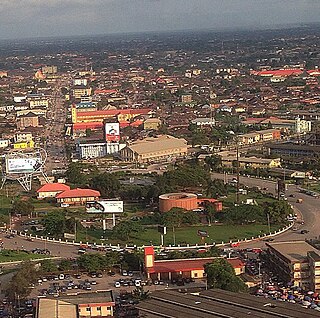
Benin City is the capital and largest city of Edo State, Nigeria. It is the fourth-largest city in Nigeria according to the 2006 census, after Lagos, Kano, and Ibadan, with a population estimate of about 1,500,000 as of 2016. It is situated approximately 40 kilometres (25 mi) north of the Benin River and 320 kilometres (200 mi) by road east of Lagos. Benin City is the centre of Nigeria's rubber industry, and oil production is also a significant industry.

African art describes the modern and historical paintings, sculptures, installations, and other visual culture from native or indigenous Africans and the African continent. The definition may also include the art of the African diasporas, such as: African American, Caribbean or art in South American societies inspired by African traditions. Despite this diversity, there are unifying artistic themes present when considering the totality of the visual culture from the continent of Africa.
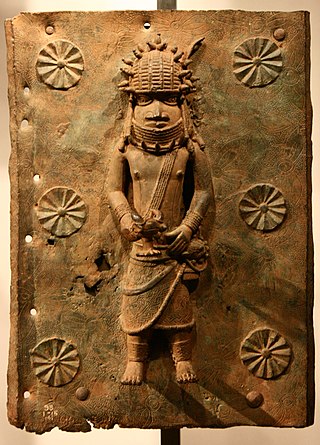
The Benin Bronzes are a group of several thousand metal plaques and sculptures that decorated the royal palace of the Kingdom of Benin, in what is now Edo State, Nigeria. Collectively, the objects form the best examples of Benin art and were created from the thirteenth century by artists of the Edo people. Apart from the plaques, other sculptures in brass or bronze include portrait heads, jewelry, and smaller pieces.
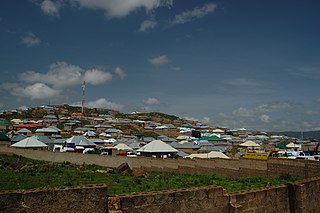
Jos is a city in the north central region of Nigeria. The city has a population of about 900,000 residents based on the 2006 census. Popularly called "J-Town", it is the administrative capital and largest city of Plateau State.
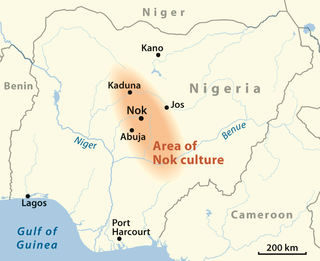
The Nok culture is a population whose material remains are named after the Ham village of Nok in Kaduna State of Nigeria, where their terracotta sculptures were first discovered in 1928. The Nok peoples and the Gajiganna peoples may have migrated from the Central Sahara, along with pearl millet and pottery, diverged prior to arriving in the northern region of Nigeria, and thus, settled in their respective locations in the region of Gajiganna and Nok. Nok people may have also migrated from the West African Sahel to the region of Nok. Nok culture may have emerged in 1500 cal BCE and continued to persist until 1 cal BCE.
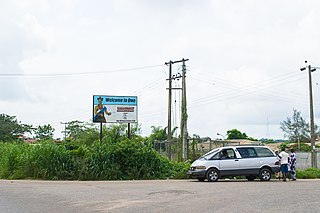
Owo is a local government area in Ondo state, Nigeria. Between 1400 and 1600 CE, it was the capital of a Yoruba city-state. The local government area has a population of 222,262 based on 2006 population census.
Christopher Uchefuna Okeke, also known as Uche Okeke, was an illustrator, painter, sculptor, and teacher. He was an art and aesthetic theorist, seminal to Nigerian modernism.
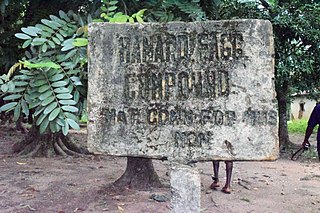
Bernard Evelyn Buller Fagg MBE, was a British archaeologist and museum curator who undertook extensive work in Nigeria before and after the Second World War.

Benin art is the art from the Kingdom of Benin or Edo Empire (1440–1897), a pre-colonial African state located in what is now known as the Southern region of Nigeria. Primarily made of cast bronze and carved ivory, Benin art was produced mainly for the court of the Oba of Benin – a divine ruler for whom the craftsmen produced a range of ceremonially significant objects. The full complexity of these works can be appreciated through the awareness and consideration of two complementary cultural perceptions of the art of Benin: the Western appreciation of them primarily as works of art, and their understanding in Benin as historical documents and as mnemonic devices to reconstruct history, or as ritual objects. This original significance is of great importance in Benin.

The Yoruba of West Africa are responsible for a distinct artistic tradition in Africa, a tradition that remains vital and influential today.
The National Administration of Cultural Heritage is an administrative agency subordinate to the Ministry of Culture and Tourism of the People's Republic of China. It is responsible for the development and management of museums as well as the protection of cultural relics of national importance.
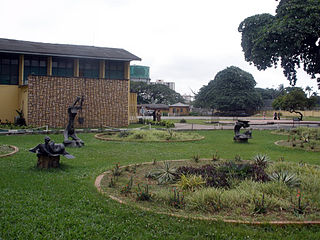
The Nigerian National Museum is a national museum of Nigeria, located in the city of Lagos. The museum has a notable collection of Nigerian art, including pieces of statuary, carvings also archaeological and ethnographic exhibits. Of note is a terracotta human head known as the Jemaa Head, part of the Nok culture. The piece is named after Jema'a, the village where it was discovered. The museum is located at Onikan, Lagos Island, Lagos State. The museum is administered by the National Commission for Museums and Monuments.
William Buller Fagg was a British curator and anthropologist. He was the Keeper of the Department of Ethnography at the British Museum (1969–1974), and pioneering historian of Yoruban and Nigerian art, with a particular focus on the art of Benin.

The Bronze Head from Ife, or Ife Head, is one of eighteen copper alloy sculptures that were unearthed in 1938 at Ife in Nigeria, the religious and former royal centre of the Yoruba people. It is believed to represent a king. It was probably made in the fourteenth-fifteenth century C.E. The realism and sophisticated craftsmanship of the objects challenged the offensive and patronising Western conceptions of African art. The naturalistic features of the Ife heads are unique and the stylistic similarities of these works "suggest that they were made by an individual artist or in a single workshop."

The Benin ivory mask is a miniature sculptural portrait in ivory of Idia, the first Iyoba of the 16th century Benin Empire, taking the form of a traditional African mask. The masks were looted by the British from the palace of the Oba of Benin in the Benin Expedition of 1897.

The Apapa Hoard is an important collection of medieval bronze jewellery found at Apapa near Lagos, Nigeria. Dating to the early 16th Century, the hoard has been part of the British Museum's collection since 1930.
Ewuare II was crowned the Oba of Benin on 20 October 2016. He is the 39th Oba, a title created for the Head of State (Emperor) of the Benin Empire at some time between 1180 and 1300.

Peju Layiwola is an art Historian and visual artist from Nigeria who works in a variety of media and genre. She is listed as a "21st Century Avant-Garde" in the book Art Cities of the Future published by Phaidon Press She is currently a Professor of Art and Art history at the University of Lagos and has been described as a "multitalented artist." Her works can be found in the collection of Microsoft Lagos, Yemisi Shyllon Museum, Pan Atlantic, Lagos and homes of private collectors such as JP and Ebun Clark and the Obi of Onitsha.

The Ife National Museum is a museum located in Osun State, Nigeria. The museum is dedicated to exhibiting objects from Ancient Ife, some of these objects are made of terracotta or bronze. The museum is administered by the National Commission for Museums and Monuments of Nigeria.

"Lower Niger Bronze Industry" is essentially a catch-all term referring either to any unattributed "Bronze" work produced in the Lower Niger, or, more commonly, to every "Bronze" work produced in the Lower Niger which cannot be immediately attributed to more famous traditions of Benin and Yoruba metallurgy. These works, referred to in recent texts as LNBs, are quite distinct from previously mentioned ones in both style and production, but are also internally diverse; they do not comprise a single tradition: "while this omnibus term is still with us, no one would continue to lump the Tada-Jebba bronzes together with those excavated at Igbo-Ukwu, even as sub-styles. These and the other provisional groupings reflect distinctly different traditions. Today even the search for a single alternate bronzecasting center has broadened as several independent workshops have been confirmed." As such, one may consider "Lower Bronze Industry" to actually mean Bronze-works which have not yet been assigned to broader traditions, or whose encapsulating traditions/contexts are poorly understood - different scholars additionally do not agree on which pieces should be given the classification. However, though little is known about them, their mere existence suggests that Bronze working was more widely spread in Nigeria than was once known.
















